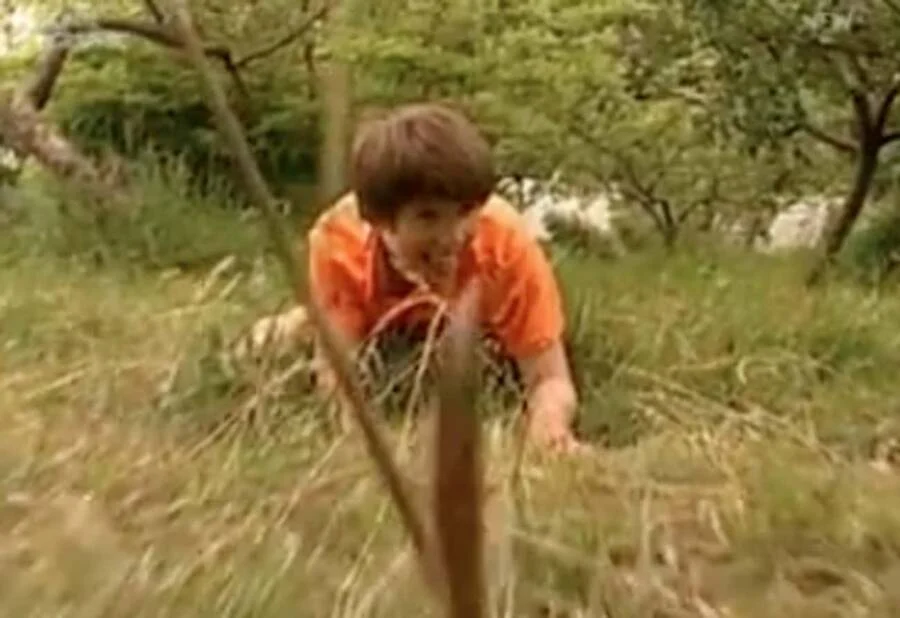After she was abandoned by her parents, Oxana Malaya lived with a pack of dogs for nearly five years — and picked up some dog-like behaviors during her time with them.

Mark McDermott/YouTubeOxana Malaya spent nearly five years living in a kennel with stray dogs.
On one bitterly cold night in the 1980s, a three-year-old Ukrainian girl named Oxana Malaya was left out overnight by her neglectful alcoholic parents.
Desperate for warmth and shelter, she followed her dog Naida into her family’s dog kennel — and stayed there for nearly five years.
During this time, she lived with a pack of strays and picked up a number of dog-like behaviors. By the time authorities finally found her, she fully behaved like a dog, crawling around on all fours, barking, and sleeping on the floor.
Oxana Malaya’s Life With The Dogs
Oksana Oleksandrivna Malaya, or Oxana Malaya, was born on November 4, 1983. She grew up in poverty in Nova Blagovishchenka, Ukraine. Her parents, who struggled with alcoholism, ignored her for most of her childhood.
“Mum had too many kids,” Oxana later told 60 Minutes, according to The U.S. Sun. “We didn’t have enough beds.”
So when she got locked out of the house one night, that’s where she stayed. She soon joined a pack of local strays, surviving on raw meat and scraps. She gradually lost all ability to speak, instead communicating in barks and growls.
“I would talk to them they would bark and I would repeat it,” she said. “That was our way of communication.”
Her unusual living situation went unnoticed for nearly five years. It wasn’t until Oxana barked at a neighbor that anyone suspected anything was wrong.
How Oxana Malaya Was Finally Rescued
When authorities finally found Oxana Malaya, the pack of dogs had come to view her as one of their own. They were so protective of Oxana that they wouldn’t let the police get anywhere near her. Officers had to lure the dogs away with food so they could take Oxana away.
Oxana was taken to a children’s home, where she was given years of intense, specialized therapy and education.
“She was more like a little dog than a human child,” the director of the institute said in an interview with 60 Minutes. “She used to show her tongue when she saw water and she used to eat with her tongue and not her hands.”
Despite not speaking any human language until she was almost eight years old, she picked up language and other basic skills fairly quickly.
Still, her doctors said it was unlikely she will ever be completely rehabilitated. Even though Oxana is now about 40 years old, researchers still consider her level of development and intellectual capacity to be comparable to that of a six-year-old.

Mark McDermott/YouTubeBy the time authorities found seven-year-old Oxana Malaya, she fully behaved like a dog.
Today, Oxana Malaya lives in a special care home, where she spends most of her time looking after animals. Despite her progress, she says she sometimes reverts back to dog-like behavior.
“When I feel lonely… I crawl on all fours. This is how lonely I feel,” she said, according to The Sun. “Because I have nobody, I spend my time with dogs, I go for walks and do anything I want to. Nobody notices that I walk on all fours.”
Nature Versus Nurture
Oxana Malaya’s condition furthers the scientific debate about “nature versus nurture” when it comes to how a child is raised.
“Nature,” in the context of this debate, refers to a person’s innate being, predetermined by factors like genetics. “Nurture,” on the other hand, means environmental factors during a child’s development, such as social interaction, childhood experiences, and whether or not basic needs are met.
Personality and behavioral traits lie at the center of the nature versus nurture debate. For instance, are children who are aggressive or grow up to commit violent crimes born that way, or are their violent tendencies the result of the way they were raised?
Scientists have come to somewhat of a consensus that both nature and nurture play important roles in shaping personality. But the question still remains — which is the most influential?

Mark McDermott/YouTubeAfter intensive therapy, Oxana Malaya developed language skills and learned to walk upright.
Oxana Malaya’s case certainly indicates that nurture has a profound influence on a child. The fact that she developed doglike behaviors — complete with canine appetites, habits, and vocalizations — emphasized the importance of socialization in shaping one’s personality.
In recent years, research in the field of epigenetics, or the study of how environmental factors change the way genes function, has lended support to the theory of “nature through nurture,” which suggests that traits have both inherent genetic and environmental influences.
This is seen commonly among cases of extreme emotional distress, mental illness, or personality disorders. A prominent example is psychopathy, which is often inherent in a person’s genetics but gets triggered by intensely negative environmental factors.
“Epigenetic stressors during early childhood can make certain genetic traits like the hallmarks of psychopathy turn against someone in a bad way,” writes Dr. Caroline Leaf. “The cortisol from abuse, trauma, or being abandoned can shape how they interact with others by affecting the development of their ability to socialize.”
‘Feral’ Children And Rehabilitation Into A Normal Life
Sadly, Oxana Malaya is far from the only child who suffered this kind of parental abandonment or neglect.
In Russia in 2008, a seven-year-old boy named Vanya Yudin was rescued from his mother’s home when it was discovered that she had been raising him as a pet bird. He could only communicate through chirps, and was sent to a psychological care center for rehabilitation.
“[His mother] had her own domestic birds and fed wild ones. [She] neither beat him nor left him without food. She just never talked to him. It was all the birds that communicated with the boy and taught him birds’ language,” the Russian newspaper Pravda reported, according to the Daily Mail. “He just chirps and when realizing that he is not understood, starts to wave hands in the way birds winnow wings.”
In another case in 1970, a girl named “Genie” Wiley was brought to a children’s hospital in Los Angeles, where doctors said she was “the most profoundly damaged child they had ever seen,” according to The Guardian.
Her father, Clark Wiley, had slipped into a state of rage and depression after his mother was killed by a drunk driver, and he locked Genie in a tiny bedroom when she was just 20 months old. For most of her childhood, she was restrained in a homemade straitjacket and always harnessed to either a toilet seat or a wire mesh-covered crib.
Genie’s mother, Irene, finally fled from Clark after a decade of abuse, alerting welfare officers to Genie’s condition. When they found her, she weighed under 60 pounds, and while she at first appeared no older than six or seven, she was soon determined to be 13 years old. She was sent to a children’s hospital, and is believed to still be under state care today.
Children like these who have been deprived of human contact from a young age are commonly referred to as feral children. These children often have incredible difficulties reintegrating into society, as they lack socialization and language skills.
While many feral children, such as Oxana Malaya, can regain these skills to some degree, Susan Curtiss, a linguistics professor who studied and befriended Genie, said that the window for linguistic ability seems to close when a child is between five and 10 years old. After that, some communication skills and vocabulary can be gained, but one’s understanding of grammar and ability to communicate in sentences is likely past the point of no return.
“Does language make us human? That’s a tough question,” Curtiss told The Guardian. “It’s possible to know very little language and still be fully human, to love, form relationships, and engage with the world. Genie definitely engaged with the world.”
After learning about Oxana Malaya, the girl who was raised by dogs, read about the real-life feral child who may have inspired “The Jungle Book.” Then, discover the heartwarming stories behind some of the world’s most famous dogs.





